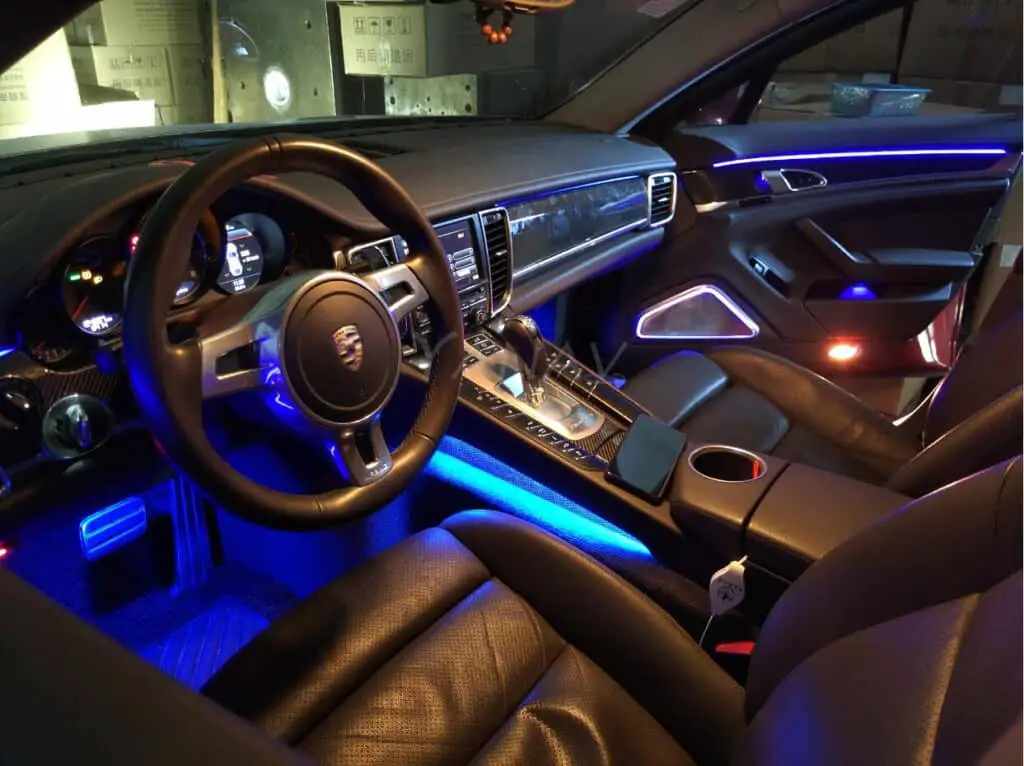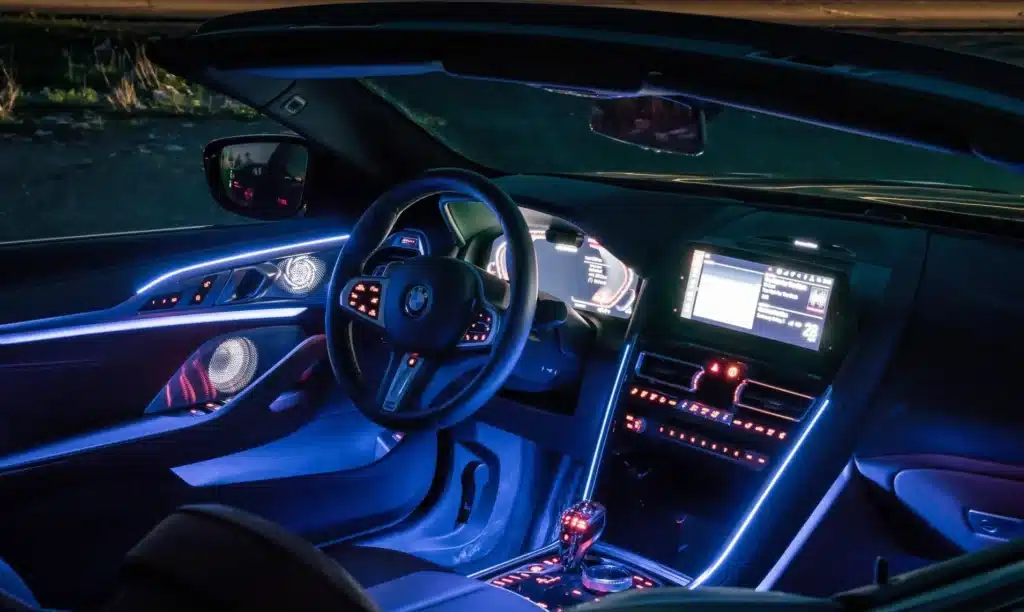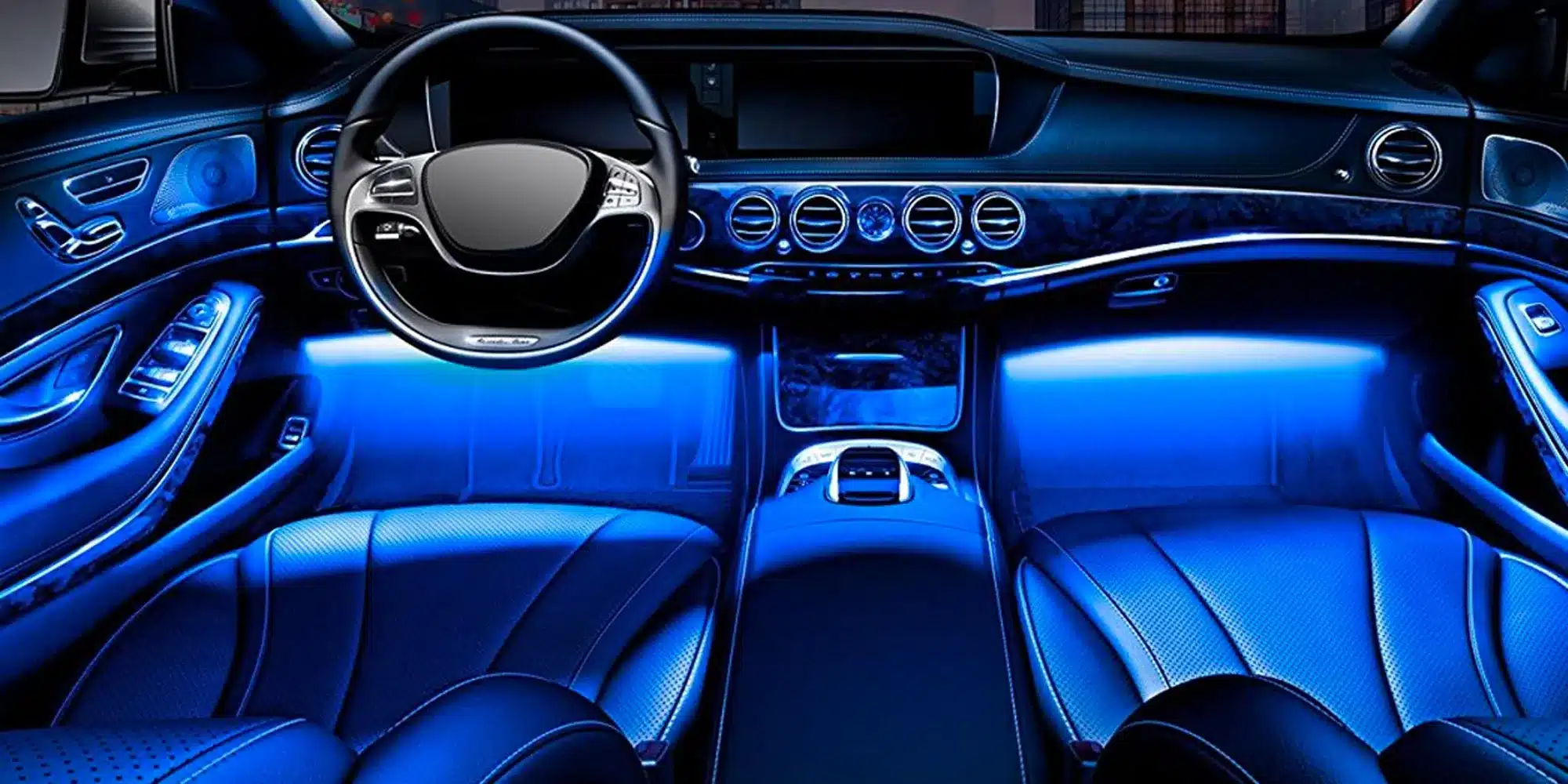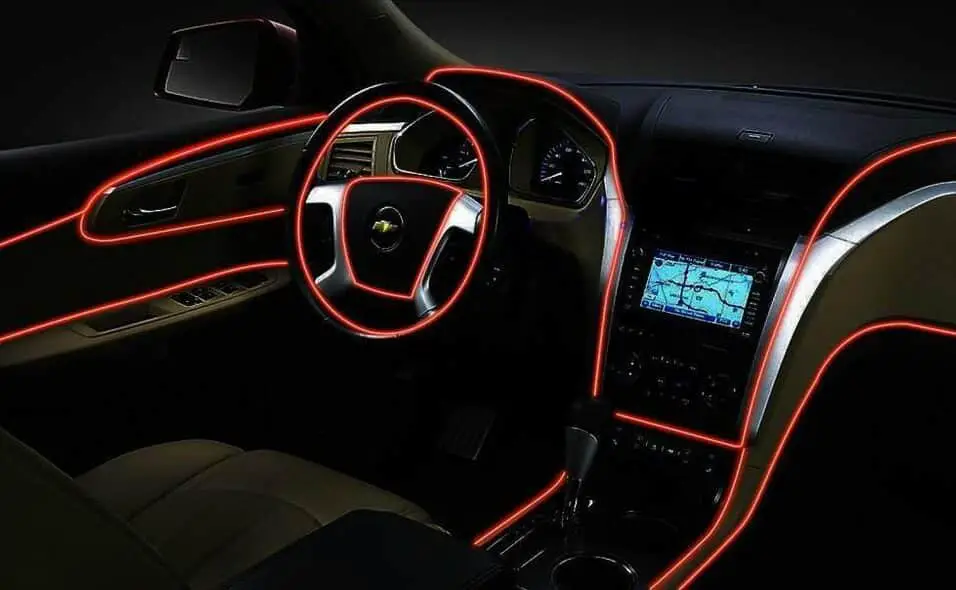How To Install LED Lights In Car Interior
Introduction
How To Install LED Lights In Car Interior: LED lights have become increasingly popular for car enthusiasts looking to enhance the interior of their vehicles. Not only do LED lights add a stylish and modern touch to the car’s interior, but they also provide improved visibility and safety.
Benefits of LED Lights in Car Interior: LED lights offer several advantages over traditional incandescent or halogen bulbs when it comes to car interior lighting. Firstly, LED lights are highly energy-efficient, consuming significantly less power than conventional bulbs. This means that you can enjoy the benefits of brighter and more vibrant lighting without putting a strain on your car’s electrical system. Additionally, LED lights have a longer lifespan compared to traditional bulbs, reducing the need for frequent replacements and saving you money in the long run.
Furthermore, LED color lights emit a brighter and more focused light, improving visibility inside the car. This is particularly beneficial during nighttime driving or when searching for items in the car’s interior. LED lights also come in a variety of colors, allowing you to customize the lighting to suit your personal style and preferences. Whether you prefer a calming blue hue or a bold red glow, LED lights offer endless possibilities for creating a unique and personalized interior lighting setup.

Can I put LED lights in the interior of my car?
Contrary to popular belief, it is legal to have LED lights inside your car. Although they make your car’s interior look cool, they also illuminate the inside, making it harder to see outside. However, you can still stay cool and trendy while maintaining safety standards.
Yes, you can definitely put LED lights in the interior of your car. LED lights have become increasingly popular among car enthusiasts for their versatility and aesthetic appeal. LED lights not only enhance the overall look of the car’s interior but also provide practical benefits such as improved visibility and convenience.
One of the main advantages of LED lights is their energy efficiency.
LED lights consume significantly less power compared to traditional incandescent bulbs, making them an ideal choice for car owners who want to reduce their energy consumption. Additionally, LED lights have a longer lifespan, which means you won’t have to worry about replacing them frequently.
Furthermore, LED lights can be easily installed in your car’s interior without the need for any complex wiring or modifications. Many LED light kits come with adhesive backing, making it simple to attach them to various surfaces.
LED lights are a great addition to the interior of your car. They offer numerous benefits such as energy efficiency, customization options, and easy installation.
What are the LED lights inside a car called?
LED light diffuser plates and Light Guide Plates have been widely used in automotive lighting. These can be located on the ceiling of the vehicle and illuminate when people enter or exit the car.
The LED lights inside a car serve several purposes.
They provide general illumination, allowing passengers to see inside the vehicle at night or in low light conditions. LED lights also enhance the overall aesthetic of the car’s interior, creating a more modern and stylish look.
LED lights offer several advantages over traditional incandescent or fluorescent lights. They are more energy efficient, meaning they consume less power and produce less heat. This not only helps to reduce the vehicle’s energy consumption but also prolongs the lifespan of the lights.
Are car interior LED lights worth it?
Especially if you plan on keeping your car for a long time, LEDs are less expensive in the long run. Compared to other types of bulbs, LEDs are efficient. The vast majority of the energy fed into an LED produces just one thing — light.
Car interior LED lights have become increasingly popular among car enthusiasts and owners in recent years. However, the question remains: are car interior LED lights worth it?
Energy-Efficient Brilliance: The Advantages of LED Car Interior Lights
Another benefit of car interior LED lights is their energy efficiency. This not only helps to reduce the strain on the car’s electrical system but also contributes to fuel efficiency. With LED lights, car owners can enjoy the benefits of enhanced interior lighting without worrying about draining the car’s battery or increasing fuel consumption.
In addition to their aesthetic and energy-saving advantages, car interior LED lights also offer practical benefits. These lights can improve visibility inside the car, especially during nighttime driving. The bright and focused illumination provided by LED lights can help drivers locate items, read maps, and operate controls more easily. This can enhance safety and convenience, particularly for long drives or in unfamiliar areas.
However, it’s important to consider the potential drawbacks of car interior LED lights. Some people may find the bright and colorful lighting distracting or even irritating, especially during nighttime driving. Additionally, the installation process can be complex and time-consuming, requiring knowledge of electrical systems and wiring.
Can I connect LED directly to 12V battery?
Due to the lack of stability, it is never a good idea to power the 12V LED strip directly from the car battery. Doing so can cause the strips to overheat and shorten their life. Instead of connecting them directly, you need a voltage regulator.
Yes, you can connect an LED directly to a 12V battery, but it is important to consider a few factors before doing so. LEDs, or Light Emitting Diodes, are low voltage devices that typically operate at around 2-3 volts. However, they can handle higher voltages, such as 12V, as long as certain precautions are taken.
Key Considerations for LED Circuit Design: Voltage, Current, and Polarity
Firstly, it is important to determine the forward voltage drop of the LED you are using. This is the voltage required for the LED to turn on and emit light. Most LEDs have a forward voltage drop of around 2-3 volts, but it can vary depending on the specific LED.
Secondly, you need to consider the current rating of the LED. LEDs have a maximum current rating, which is the amount of current they can safely handle without getting damaged. Exceeding this current rating can cause the LED to overheat and fail.
Lastly, it is important to consider the polarity of the LED. LEDs are polarized devices, which means they have a positive and negative terminal. Connecting the LED to the battery with the correct polarity is crucial for it to function properly.
While it is possible to connect an LED directly to a 12V battery, it is important to consider the forward voltage drop, current rating, and polarity of the LED to ensure its proper operation and prevent damage. Using a current-limiting resistor or a current-regulating circuit may be necessary depending on the specific LED and battery voltage.”
Can LED lights run on 12V?
A: LED lights come in two versions: a line-voltage version that can be directly operated on a 120V mains supply and a low-voltage version that can be operated on a 12V or 24V power supply.
Yes, LED lights can run on 12V. In fact, LED lights are designed to operate on low voltage systems, making them highly versatile and energy-efficient lighting options.
LED stands for Light Emitting Diode, which is a semiconductor device that emits light when an electric current passes through it. LEDs have become increasingly popular in recent years due to their numerous advantages over traditional lighting technologies.
Efficient Illumination: Harnessing the Power of 12V LED Systems
Many applications require the use of 12V systems, such as automotive lighting, RV lighting, and solar-powered lighting. LED lights are the perfect choice for these applications as they can easily be powered by a 12V power source. Additionally, LED lights are highly durable and long-lasting, making them ideal for outdoor and rugged environments.
It is important to note that while LED lights can run on 12V, they often require a driver or transformer to convert the voltage from the power source to the appropriate level for the LEDs. This is because LEDs operate on low voltage DC (direct current), while most power sources provide higher voltage AC (alternating current). The driver or transformer ensures that the voltage is properly regulated for the LEDs to function optimally.
LED lights can indeed run on 12V. Their ability to operate on low voltage systems makes them a versatile and energy-efficient lighting option for various applications.
Installing LED lights in a car’s interior can be a fun and relatively simple DIY project.
Here are the steps involved in the installation process:
1: Start by gathering all the necessary materials and tools, including LED light strips, a power source, wire connectors, electrical tape, and a screwdriver.
2: Begin by disconnecting the car’s battery to ensure safety during the installation process.
3: Determine where you want to place the LED light strips in your car’s interior. Common areas include under the dashboard, along the footwells, or in the trunk.
4: Clean the chosen areas thoroughly to ensure proper adhesion of the LED light strips.
5: Peel off the adhesive backing of the LED light strips and carefully stick them in the desired locations.
6: Connect the LED light strips to the power source using wire connectors. Make sure to follow the manufacturer’s instructions for proper wiring.
7: Once the wiring is complete, reconnect the car’s battery and test the LED lights to ensure they are functioning correctly.
By following these steps, you can successfully install LED lights in your car’s interior and enjoy a vibrant and customizable lighting experience.
What tools or equipment are needed to install LED lights in a car’s interior?
When it comes to installing LED lights in a car’s interior, there are a few essential tools and equipment that you will need to ensure a successful installation. Firstly, you will need a set of LED lights specifically designed for automotive use. These can be purchased online or at an automotive parts store. Additionally, you will need a power source for the lights, such as a 12-volt power supply or a car battery. It is important to ensure that the power source is compatible with the LED lights you are using.
In terms of tools, you will need a wire stripper and crimping tool to properly connect the wires of the LED lights to the power source. A soldering iron may also be necessary for more secure connections. It is important to have electrical tape or heat shrink tubing to insulate the connections and prevent any short circuits.
Are there any specific precautions or safety measures to consider when installing LED lights in a car’s interior?
Another important precaution is to handle the LED lights with care. Additionally, it is important to avoid touching the LED bulbs directly with bare hands, as the oils from the skin can cause the bulbs to overheat and fail prematurely.
Furthermore, it is crucial to follow the manufacturer’s instructions and guidelines for installation. Each LED light kit may have specific requirements and recommendations, such as the appropriate voltage, wiring connections, and mounting locations.
Can LED lights be installed in any type of car, or are there specific models or makes that are more compatible?
It is important to research and ensure that the LED lights you choose are compatible with your specific car model. Some cars may require additional wiring or adapters to properly install the LED lights. Consulting the car’s manual or seeking professional advice can help determine the compatibility and any specific requirements for your car.
Are there any additional features or customization options available when installing LED lights in a car’s interior?
When it comes to installing LED lights in a car’s interior, there are indeed several additional features and customization options available. These options allow car owners to personalize their lighting setup and create a unique ambiance inside their vehicle. One popular customization option is the ability to choose from a wide range of colors for the LED lights.
In addition to color options, there are also different lighting patterns and effects that can be achieved with LED lights. Other kits may have a strobe or fade feature, allowing you to create a more dramatic lighting effect.

Conclusion
One of the key advantages of installing LED lights in the car interior is the wide range of customization options available. This allows car owners to personalize their vehicle and create a unique atmosphere that suits their preferences.
Furthermore, LED lights are known for their longevity and durability. Unlike traditional incandescent bulbs, LED lights have a much longer lifespan and are less prone to damage from vibrations or shocks. This means that once installed, car owners can enjoy the benefits of LED lights for an extended period without the need for frequent replacements or repairs.
Installing LED lights in the car interior is a great way to enhance the overall aesthetics and functionality of the vehicle. With their easy installation process, customizable options, and long-lasting performance, LED lights offer a cost-effective and visually appealing solution for car owners. Whether it’s for practical purposes such as improved visibility or for creating a unique ambiance, LED lights are a worthwhile investment for any car enthusiast.








